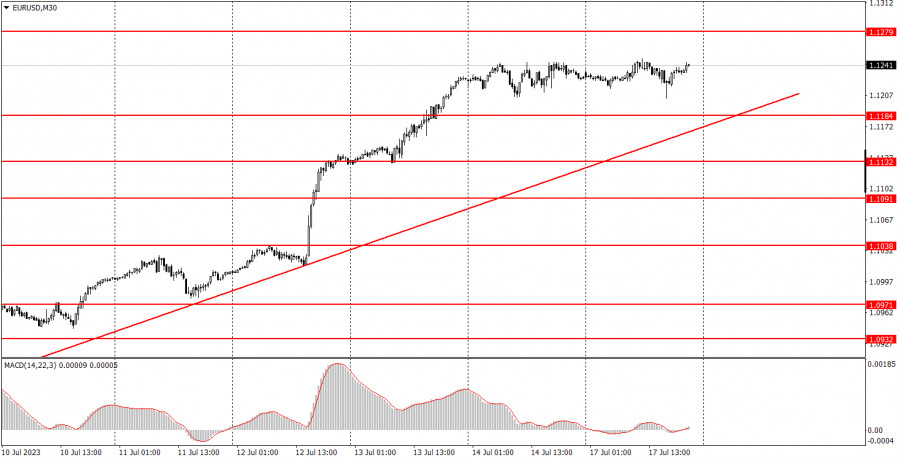

The EUR/USD pair continued trading in a tight range during the first day of the week. There were no significant movements, fundamental events, or macroeconomic reports throughout the day. It seemed improbable that the market would remain flat for two consecutive days, given the strong growth witnessed last week which called for a correction. However, the market decided otherwise and continued to stay in a tight range at the highest price levels seen in the last 15 months. The upward trendline remains relevant, thus sustaining the upward trend. There is nothing more to add regarding the current technical picture.
EUR/USD 5M chart
On the 5-minute timeframe on Monday, no trading signals were formed. This is a positive aspect because when the price reaches any level in a flat market, it often generates numerous false signals, which happened on Friday. With volatility at 45 pips, trading becomes extremely difficult even during a trending movement.
Trading strategy for Tuesday:On the 30-minute timeframe, the pair continues to form an upward trend. Friday and Monday provided excellent opportunities for a slight correction despite an empty economic calendar, but the market did not take advantage of it. So, the unjustified and surprising rise of the euro may continue this week. On the 5-minute timeframe tomorrow, the key levels can be found at 1.0871, 1.0901, 1.0932, 1.0971-1.0977, 1.1038, 1.1091, 1.1132, 1.1184, 1.1279-1.1292, 1.1330, and 1.1367. When the price moves 15 pips in the right direction, it is recommended to set the stop-loss at breakeven. On Tuesday, the macroeconomic events calendar in the European Union is empty again, while the US will release a few less significant reports such as retail sales and industrial production data. The likelihood of these reports supporting the dollar is extremely low, even if they turn out to be stronger than forecasted.
The basic rules of a trading system:1) The strength of the signal depends on the time period during which the signal was formed (a rebound or a break). The shorter this period, the stronger the signal.
2) If two or more trades were opened at some level following false signals, i.e. those signals that did not lead the price to Take Profit level or the nearest target levels, then any consequent signals near this level should be ignored.
3) During the flat trend, any currency pair may form a lot of false signals or do not produce any signals at all. In any case, the flat trend is not the best condition for trading.
4) Trades are opened in the time period between the beginning of the European session and until the middle of the American one when all deals should be closed manually.
5) We can pay attention to the MACD signals in the 30M time frame only if there is good volatility and a definite trend confirmed by a trend line or a trend channel.
6) If two key levels are too close to each other (about 5-15 pips), then this is a support or resistance area.
How to read charts:Support and Resistance price levels can serve as targets when buying or selling. You can place Take Profit levels near them.
Red lines are channels or trend lines that display the current trend and show which direction is better to trade.
MACD indicator (14,22,3) is a histogram and a signal line showing when it is better to enter the market when they cross. This indicator is better to be used in combination with trend channels or trend lines.
Important speeches and reports that are always reflected in the economic calendars can greatly influence the movement of a currency pair. Therefore, during such events, it is recommended to trade as carefully as possible or exit the market in order to avoid a sharp price reversal against the previous movement.
Beginning traders should remember that every trade cannot be profitable. The development of a reliable strategy and money management are the key to success in trading over a long period of time.